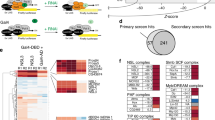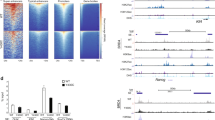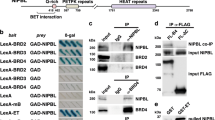Abstract
We found that the clinical phenotype associated with BRD4 haploinsufficiency overlapped with that of Cornelia de Lange syndrome (CdLS), which is most often caused by mutation of NIPBL. More typical CdLS was observed with a de novo BRD4 missense variant, which retained the ability to coimmunoprecipitate with NIPBL, but bound poorly to acetylated histones. BRD4 and NIPBL displayed correlated binding at super-enhancers and appeared to co-regulate developmental gene expression.
This is a preview of subscription content, access via your institution
Access options
Access Nature and 54 other Nature Portfolio journals
Get Nature+, our best-value online-access subscription
$29.99 / 30 days
cancel any time
Subscribe to this journal
Receive 12 print issues and online access
$209.00 per year
only $17.42 per issue
Buy this article
- Purchase on Springer Link
- Instant access to full article PDF
Prices may be subject to local taxes which are calculated during checkout


Similar content being viewed by others
Change history
03 June 2019
An amendment to this paper has been published and can be accessed via a link at the top of the paper.
References
Hnisz, D. et al. Cell 155, 934–947 (2013).
Rao, S. S. P. et al. Cell 171, 305–320 (2017).
Watrin, E., Kaiser, F. J. & Wendt, K. S. Curr. Opin. Genet. Dev. 37, 59–66 (2016).
Yuan, B. et al. J. Clin. Invest. 125, 636–651 (2015).
Bot, C. et al. J. Cell Sci. 130, 1134–1146 (2017).
Zuin, J. et al. PLoS Genet. 10, e1004153 (2014).
Haarhuis, J. H. I. et al. Cell 169, 693–707 (2017).
Ciosk, R. et al. Mol. Cell 5, 243–254 (2000).
Schwarzer, W. et al. Nature 551, 51–56 (2017).
Deardorff, M. A. et al. Am. J. Hum. Genet. 90, 1014–1027 (2012).
Gil-Rodríguez, M. C. et al. Hum. Mutat. 36, 454–462 (2015).
Musio, A. et al. Nat. Genet. 38, 528–530 (2006).
Deardorff, M. A. et al. Nature 489, 313–317 (2012).
Ansari, M. et al. J. Med. Genet. 51, 659–668 (2014).
Parenti, I. et al. Clin. Genet. 89, 74–81 (2016).
Izumi, K. et al. Nat. Genet. 47, 338–344 (2015).
Deciphering Developmental Disorders Study. Nature 542, 433–438 (2017).
Kline, A. D. et al. Am. J. Med. Genet. A. 143A, 1287–1296 (2007).
Houzelstein, D. et al. Mol. Cell. Biol. 22, 3794–3802 (2002).
Kawauchi, S. et al. PLoS Genet. 5, e1000650 (2009).
Zhang, J. et al. Cancer Discov. 7, 322–337 (2017).
Kanno, T. et al. Nat. Struct. Mol. Biol. 21, 1047–1057 (2014).
Vollmuth, F., Blankenfeldt, W. & Geyer, M. J. Biol. Chem. 284, 36547–36556 (2009).
Gerth-Kahlert, C. et al. Mol. Genet. Genomic Med. 1, 15–31 (2013).
Filippakopoulos, P. et al. Nature 468, 1067–1073 (2010).
Pradeepa, M. M., Sutherland, H. G., Ule, J., Grimes, G. R. & Bickmore, W. A. PLoS Genet. 8, e1002717 (2012).
Turriziani, B. et al. Biology 3, 320–332 (2014).
Cox, J. et al. Mol. Cell. Proteomics 13, 2513–2526 (2014).
Johnson, D. S., Mortazavi, A., Myers, R. M. & Wold, B. Science 316, 1497–1502 (2007).
Pradeepa, M. M. et al. Nat. Genet. 48, 681–686 (2016).
Illingworth, R. S. et al. Genes Dev. 29, 1897–1902 (2015).
Ritchie, M. E. et al. Nucleic Acids Res. 43, e47 (2015).
Langmead, B. & Salzberg, S. L. Nat. Methods 9, 357–359 (2012).
Ramírez, F. et al. Nucleic Acids Res. 44 (W1), W160–W165 (2016).
ENCODE Project Consortium. Nature 489, 57–74 (2012).
Quinlan, A. R. & Hall, I. M. Bioinformatics 26, 841–842 (2010).
Wei, Y. et al. Nucleic Acids Res. 44 (D1), D172–D179 (2016).
Acknowledgements
We thank the CdLS Foundation of the UK and Ireland and particularly the families of the affected children for their time and support for the research. G.O., M.A., H.B., W.A.B., M.M.P. and D.R.F. were funded by the MRC University Unit award to the University of Edinburgh for the MRC Human Genetics Unit. The work of A.v.K. was supported by Carnegie Trust Research Incentive Grant 70382. The DDD study presents independent research commissioned by the Health Innovation Challenge Fund (grant HICF-1009-003), a parallel funding partnership between the Wellcome Trust and the Department of Health, and the Wellcome Trust Sanger Institute (grant WT098051). The views expressed in this publication are those of the authors and not necessarily those of the Wellcome Trust or the Department of Health. The research team acknowledges the support of the National Institute for Health Research through the Comprehensive Clinical Research Network.
Author information
Authors and Affiliations
Consortia
Contributions
W.A.B., M.M.P. and D.R.F. conceived the study. D.R.F., W.A.B. and M.M.P. wrote the manuscript. All of the authors read and commented on the manuscript. G.O., M.A., H.B., N.C., M.M.P. and the DDD study generated the molecular biology and animal model data. A.v.K. generated and analyzed the mass spectrometry data. F.J.S., E.W., A.R. and S.M.P. provided expert clinical interpretation and details of the phenotype for each affected individual. A.B. performed the meta-analysis of the reported deletion cases. J.R. provided expert technical advice and cell reagents. G.R.G. performed the genomic and transcriptomic informatic analysis.
Corresponding authors
Ethics declarations
Competing interests
The authors declare no competing financial interests.
Additional information
Publisher's note: Springer Nature remains neutral with regard to jurisdictional claims in published maps and institutional affiliations.
Supplementary information
Supplementary Text and Figures
Supplementary Figures 1–20, Supplementary Tables 1–3 and Supplementary Note
Supplementary Table 4
BRD4 immunoprecipitation data
Rights and permissions
About this article
Cite this article
Olley, G., Ansari, M., Bengani, H. et al. BRD4 interacts with NIPBL and BRD4 is mutated in a Cornelia de Lange–like syndrome. Nat Genet 50, 329–332 (2018). https://doi.org/10.1038/s41588-018-0042-y
Received:
Accepted:
Published:
Issue Date:
DOI: https://doi.org/10.1038/s41588-018-0042-y
This article is cited by
-
Neurobehavioral and developmental profiles: genotype–phenotype correlations in individuals with Cornelia de Lange syndrome
Orphanet Journal of Rare Diseases (2024)
-
A genome-wide CRISPR screen identifies BRD4 as a regulator of cardiomyocyte differentiation
Nature Cardiovascular Research (2024)
-
Context-dependent perturbations in chromatin folding and the transcriptome by cohesin and related factors
Nature Communications (2023)
-
High-sensitive nascent transcript sequencing reveals BRD4-specific control of widespread enhancer and target gene transcription
Nature Communications (2023)
-
3D chromatin architecture and transcription regulation in cancer
Journal of Hematology & Oncology (2022)



